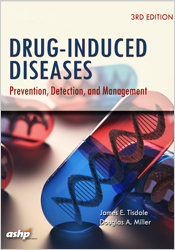Drug-Induced Diseases
Introduction
Although drug therapies can prolong and improve a patient's quality of life, they can cause harm by either exacerbating existing conditions or causing new ones. Therefore, the potential benefits of drug therapy must always be weighed carefully against the potential harm.
Currently, the growing prevalence of polypharmacy, especially in the elderly population, could lead to an increasing trend of drug-related morbidity and mortality.
Contents
As a pharmacist, I highly recommend the book Drug-Induced Diseases: Prevention, Detection and Management as an excellent resource for comprehending and preventing diseases. The book is structured into various chapters that discuss drug-induced diseases, with examples provided.
- Alopecia - Carboplatin, cisplatin, docetaxel, doxorubicin, gemcitabine, paclitaxel, pemetrexed, teniposide, topotecan, lithium,
- Anaemia - Cancer chemotherapy
- Constipation - Opioids
- Diarrhoea - Antibiotics (e.g. cephalosporins, clindamycin, fluoroquinolones, macrolides, penicillins), SSRI, SNRI
- Drug allergy - Penicillins, heparin
- Gout - Ethambutol, tacrolimus
- Heart failure - Anthracyclines, diltiazem, nifedipine,
- Hypertension - Celecoxib, cyclosporine, ivabradine, sorafenib, sunitinib, tacrolimus, venlafaxine
- Hypotension - ACE inhibitors, angiotensin-receptor blockers, calcium channel blockers, isosorbide dinitrate, nitroglycerin, propofol
- Myopathy - Statins
- Nausea and vomiting - Actinomycin D, azacitidine, cisplatin, daunorubicin, ifosfamide, irinotecan,
- Osteoporosis - Systemic glucocorticoids
- Ototoxicity - Carboplatin, cisplatin, isoniazid
- Peripheral neuropathy - Bortezomib, cisplatin, docetaxel, oxaliplatin, paclitaxel, thalidomide, vincristine
- Photosensitivity - Amiodarone, methotrexate, voriconazole
- Teratogenicity
- Thrombocytopenia - Heparin

Comments
Post a Comment